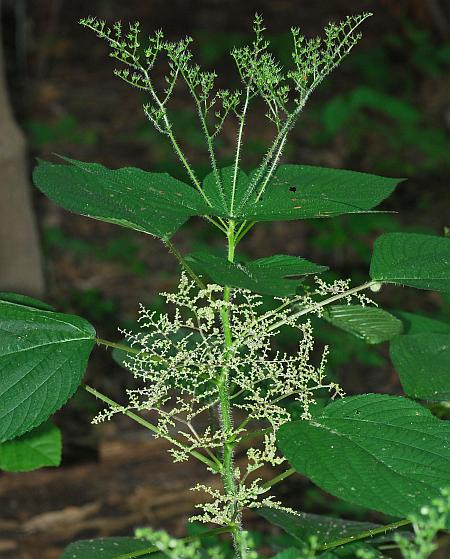Laportea canadensis (L.) Wedd.
Wood Nettle

Native
CC = 4
CW = -3
MOC = 54
© SRTurner
Laportea canadensis (L.) Wedd.Wood Nettle | |
 |
Native CC = 4 CW = -3 MOC = 54 |
© SRTurner |
|
Family - Urticaceae Habit - Monoecious, rhizomatous perennial forb, with fibrous and sometimes tuberous roots. Plant armed with long, stinging hairs, also with sparse to dense, shorter, finer, nonstinging hairs. Stem - Strongly ascending to erect, to 1.5 m, usually unbranched, often slightly zigzag, armed with stinging hairs.
Leaves - Alternate, simple, long-petiolate, stipulate. Blades 6-20 cm long, ovate to broadly ovate, broadly angled to shallowly cordate at the base, short-tapered at the tip, typically armed with stinging hairs especially on the midveins, the margins coarsely toothed, the venation pinnate or the 2 most basal lateral veins slightly more developed than the others; cystoliths rounded.
Inflorescences - Axillary (staminate) and often appearing terminal (pistillate), paniculate clusters, the staminate panicles usually shorter-stalked than the subtending petiole and positioned at nodes below the pistillate ones, which usually are longer than the subtending petiole. Bractlets absent.
Flowers - Minute, actinomorphic, hypogynous, mostly imperfect. Staminate flowers usually short-stalked, with 5 sepals, these 0.8-1.1 mm long, cupped around the stamens. Pistillate flowers sessile or short-stalked, the calyx consisting of 2 smaller sepals, these 0.2-0.3 mm long, spreading, alternating with 2 larger sepals, these 0.8-1.1 mm long, loosely cupped around but not fused to the ovary and fruit. Corollas absent. Stamens 5, free, opposite the sepals, the filaments bent inward in the bud, reflexing suddenly as the bud opens and ejecting the pollen explosively, the anthers attached basally, yellow, dehiscing by longitudinal slits. Pistil 1 per flower (reduced to a small peglike structure in staminate flowers), of 1 carpel, the ovary superior, 1-locular, with 1 ovule, the placentation basal. Style absent or 1, the stigma 1, linear or capitate.
Fruits - Achenes 2-3 mm long, obliquely attached at the tip of a short, winged stalk, strongly flattened, the body more or less circular in outline, greenish brown to dark brown, glabrous.
Flowering - May - August. Habitat - Bottomland forests, swamps, sloughs, streambanks, moist shaded areas. Origin - Native to the U.S. Lookalikes - Boehmeria cylindrica, Urtica dioica, Acalypha rhomboidea, Pilea pumila. Other info. - This plant is common across most of Missouri, less so in the northwestern regions of the state. Its North American range encompasses the eastern half of the continental U.S. and parts of Canada. Photographs taken at Weldon Spring Conservation Area, St. Charles County, MO, 8-1-2010, at Matson Hill County Park, St. Charles County, MO, 8-18-2015, and along the Busch Greenway / Duckett Creek, St. Charles County, MO, 9-25-2017 (SRTurner). |